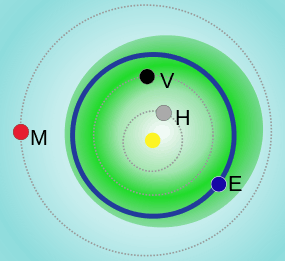(456938) 2007 YV56
| Discovery[1] | |
|---|---|
| Discovered by | Catalina Sky Survey |
| Discovery site | Catalina Mountains north of Tucson, Arizona, USA |
| Discovery date | 31 December 2007 |
| Designations | |
| MPC designation | 2007 YV56 |
| MPO 303339 | |
Apollo  NEO, PHA | |
| Orbital characteristics[2] | |
| Epoch 13 January 2016 (JD 2457400.5) | |
| Uncertainty parameter 0 | |
| Observation arc | 2959 days (8.10 yr) |
| Aphelion | 2.55575759 AU (382.335893 Gm) |
| Perihelion | 0.59547679 AU (89.082060 Gm) |
| 1.57561719 AU (235.708977 Gm) | |
| Eccentricity | 0.6220676 |
| 1.98 yr (722.39 d) | |
| 49.460731° | |
| 0° 29m 54.033s / day | |
| Inclination | 6.2450092° |
| 102.52805° | |
| 265.57058° | |
| Earth MOID | 0.0050917 AU (761,710 km) |
| Jupiter MOID | 2.91704 AU (436.383 Gm) |
| Jupiter Tisserand parameter | 4.159 |
| Physical characteristics | |
| Dimensions | 170–380 m[3] |
| 21.0[2] | |
|
| |
(456938) 2007 YV56 is a small asteroid that is a Near-Earth object and an Apollo asteroid.
Orbit
The orbit of 2007 YV56 makes it a Potentially Hazardous Asteroid (PHA) that is predicted to pass within 0.001654 AU (247,400 km) of the Earth in the year 2101.[4] For comparison, the distance to the Moon is about 0.0026 AU (384,400 km).
The Jupiter Tisserand invariant, used to distinguish different kinds of orbits, is 4.160.[2]
References
- ↑ "2007 YV56". Minor Planet Center. 2007-12-31.
- 1 2 3 "JPL Small-Body Database Browser: (2007 YV56)" (last observation: 2012-01-29; arc: 1490 days). Jet Propulsion Laboratory. Retrieved 8 April 2016.
- ↑ "ABSOLUTE MAGNITUDE (H)". NASA.
- ↑ "PHA Close Approaches To The Earth". Minor Planet Center. Retrieved 2015-05-03.
External links
| Preceded by 2011 WL2 |
Large NEO Earth close approach (inside the orbit of the Moon) 2 January 2101 |
Succeeded by 2007 UW1 |
This article is issued from Wikipedia - version of the 4/9/2016. The text is available under the Creative Commons Attribution/Share Alike but additional terms may apply for the media files.